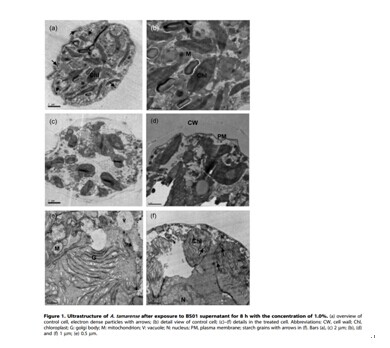Huajun
Zhang, Xinli An, Yanyan Zhou, Bangzhou Zhang, Su Zhang, Dong Li, Zhangran
Chen,Yi Li, Shijie Bai, Jinglin Lv, Wei Zheng, Yun Tian, Tianling Zheng,PLOS
ONE, 2013,8(5): e63018
Harmful algal blooms occur all over the
world, destroying aquatic ecosystems and threatening other organisms. The
culture supernatant of the marine algicidal actinomycete BS01 was able to lysis
dinoflagellate Alexandrium tamarense ATGD98-006. Physiological and biochemical
responses to oxidative stress in A. tamarense were investigated to elucidate
the mechanism involved in BS01 inhibition of algal growth. Transmission
electron microscope analysis revealed that there were some chloroplast
abnormalities in response to BS01 supernatant. The decrease in cellular-soluble
protein content suggested that cell growth was greatly inhibited at high
concentration of BS01 supernatant. The increase in the levels of reactive
oxygen species (ROS) and malondialdehyde contents following exposure to BS01
supernatant indicated that algal cells suffered from oxidative damage. The
content of pigment was significantly decreased after 12 h treatment, which
indicated that the accumulation of ROS destroyed pigment synthesis. Moreover,
the decrease of Fv/Fm ratio suggested that in the photosynthetic system, the
dominant sites producing ROS were destroyed by the supernatant of the BS01
culture. The activities of the antioxidant enzymes including superoxide
dismutase and peroxidase increased in a short time and decreased slightly with
increasing exposure time. A real-time PCR assay showed changes in the transcript
abundances of two photosynthetic genes, psbA and psbD. The results showed that
BS01 supernatant reduced the expression of the psbA gene after 2 h exposure,
but the expression of the psbD gene was increased at concentrations of 1.0 and
1.5%. Our results demonstrated that the expression of the psbA gene was
inhibited by the BS01 supernatant, which might block the electron transport
chain, significantly enhancing ROS level and excess activity of the antioxidant
system. The accumulation of ROS destoryed pigment synthesis and membrane
integrity, and inhibited or ultimately killed the algal cells.

返回

